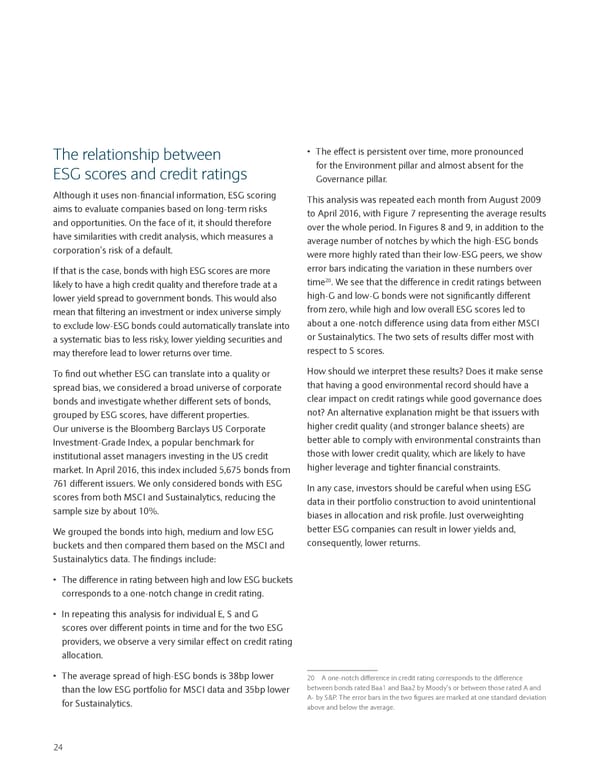The relationship between • The effect is persistent over time, more pronounced ESG scores and credit ratings for the Environment pillar and almost absent for the Governance pillar. Although it uses non-financial information, ESG scoring This analysis was repeated each month from August 2009 aims to evaluate companies based on long-term risks to April 2016, with Figure 7 representing the average results and opportunities. On the face of it, it should therefore over the whole period. In Figures 8 and 9, in addition to the have similarities with credit analysis, which measures a average number of notches by which the high-ESG bonds corporation’s risk of a default. were more highly rated than their low-ESG peers, we show If that is the case, bonds with high ESG scores are more error bars indicating the variation in these numbers over 20. We see that the difference in credit ratings between likely to have a high credit quality and therefore trade at a time lower yield spread to government bonds. This would also high-G and low-G bonds were not significantly different mean that filtering an investment or index universe simply from zero, while high and low overall ESG scores led to to exclude low-ESG bonds could automatically translate into about a one-notch difference using data from either MSCI a systematic bias to less risky, lower yielding securities and or Sustainalytics. The two sets of results differ most with may therefore lead to lower returns over time. respect to S scores. To find out whether ESG can translate into a quality or How should we interpret these results? Does it make sense spread bias, we considered a broad universe of corporate that having a good environmental record should have a bonds and investigate whether different sets of bonds, clear impact on credit ratings while good governance does grouped by ESG scores, have different properties. not? An alternative explanation might be that issuers with Our universe is the Bloomberg Barclays US Corporate higher credit quality (and stronger balance sheets) are Investment-Grade Index, a popular benchmark for better able to comply with environmental constraints than institutional asset managers investing in the US credit those with lower credit quality, which are likely to have market. In April 2016, this index included 5,675 bonds from higher leverage and tighter financial constraints. 761 different issuers. We only considered bonds with ESG In any case, investors should be careful when using ESG scores from both MSCI and Sustainalytics, reducing the data in their portfolio construction to avoid unintentional sample size by about 10%. biases in allocation and risk profile. Just overweighting We grouped the bonds into high, medium and low ESG better ESG companies can result in lower yields and, buckets and then compared them based on the MSCI and consequently, lower returns. Sustainalytics data. The findings include: • The difference in rating between high and low ESG buckets corresponds to a one-notch change in credit rating. • In repeating this analysis for individual E, S and G scores over different points in time and for the two ESG providers, we observe a very similar effect on credit rating allocation. • The average spread of high-ESG bonds is 38bp lower 20 A one-notch difference in credit rating corresponds to the difference than the low ESG portfolio for MSCI data and 35bp lower between bonds rated Baa1 and Baa2 by Moody’s or between those rated A and for Sustainalytics. A- by S&P. The error bars in the two figures are marked at one standard deviation above and below the average. 24
 Sustainable Investing and Bond Returns Page 26 Page 28
Sustainable Investing and Bond Returns Page 26 Page 28